We have not travelled far from yesterday's campsite on the outskirts of Aix-en-Provence but it seems that we are plunged into a very different world. After nine months of travelling, experiencing different situations, environments, peoples and cultures almost daily, we sometimes become rather disorientated. Was it really only yesterday we were in Aix-en-Provence and just three days since we were in the misty mountains of the Auvergne? Our sense of time changes and we find it difficult to remember where incidents that meant much at the time actually took place! That is one reason we wanted to keep this account of our travels. It will ensure we remember every detail once we return home in four months time.
When Neil was eleven we were introduced to the delightful world of Marcel Pagnol when he was given a copy of Le Château de ma Mère by his penfriend Marc, from Caen. We were all charmed with these childhood reminiscences from the renowned cinematographer and playwright from the 1930s. Born in Marseille in 1895, son of a local schoolmaster, he recalls in later life, with great affection and warmth for his family, his childhood spent with his siblings and parents at the very basic summer home in the mountains behind Marseille above the tiny village of La Treille. In 1904 the tramway was extended out from Marseille to the suburban towns of Allauch and Aubagne enabling city dwellers to occasionally escape to the hills for weekends and school holidays. As we discovered today, La Treille is still a very long walk from the tram terminal and it would have been a major undertaking for the entire family, at the start of the school holidays, to struggle their way up into the mountains on foot with everything they would need for the next few weeks. Maybe they were able to hire a horse and cart, certainly the terrain was steep, rugged, stony and very difficult.
Le Château de ma Mère tells of Marcel's delight living wild in the bare grey mountains overlooking the city of Marseille. It tells of short-cuts taken to La Treille via the Canal de Provence using a key given to them unofficially by an employee of the canal company, a former pupil of Marcel's father, enabling them to halve the distance from the tramway but necessitating crossing a private estate. (Today we saw the very gate on the canal the family used!) Marcel vividly recalls the family terror of attacks from a fierce guard-dog, and his mother's fears that his father might lose his job if they were caught. (By a curious twist of fate, in later years Marcel Pagnol, by then a famous writer and film producer, ended up purchasing the very château that had inspired so much fear in his mother.)
A later book, La Gloire de mon Père tells of the delight the young Marcel had accompanying his father when hunting the wild partridges, hares and even thrushes on the mountainside. In later life too he recalled further incidents from his childhood holidays high in the hills of Provence. Amongst his novels, later turned into films, were Jean de Florette and Manon des Sources both closely set in the village of La Treille and the hills behind.
We have always imagined what the landscape must be like and determined that one day we would go there ourselves to see just what made it all so magical. That day finally arrived today.
First we visited Allauch to get our bearings and set everything in perspective. It was very well worth a visit anyway, being a bright, clean little town high in the hills, with magnificent views down onto the city of Marseille and its suburbs. Beyond we saw the sparkling water of the Mediterranean with the offshore island of If with its castle. It was here that Alexander Dumas set his novel The Count of Monte Christo
At Allauch we climbed right to the ruined castle on the summit above the church, a hot business in bright sunshine but we were well rewarded with the spectacular view laid out beneath us. From here we could look around 360 degrees at the grey hills, the tree-line of firs, the lower slopes covered in spring flowers where huge yellow butterflies danced and twirled in pairs. Lower still were the green valleys, cypress trees and pretty pink houses with their orange and brown chequered roofs. Gradually, as the view stretched towards Marseille, the green became less and the pinks and browns more until the entire sweep of the city was laid out along the seashore with the blue of the sea beyond. From here too, we could see the mountains so beloved by Marcel Pagnol - the Garlaban, Le Taoumé and la Grande Tête Rouge. Suddenly his novels and childhood memoirs took on a reality so far only imagined from his books.
 View towards Marseille from above Allauch
View towards Marseille from above Allauch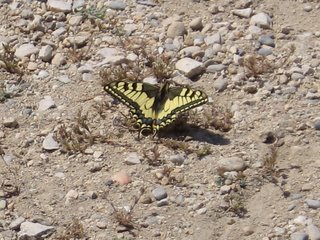 One of the huge yellow butterfies, Allauch
One of the huge yellow butterfies, Allauch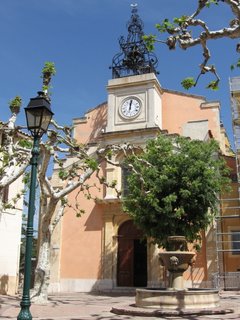 The Church, Allauch
The Church, Allauch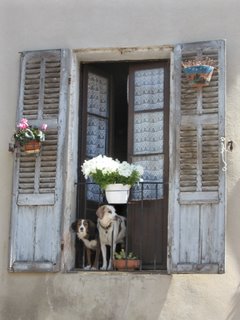 Window in a side street of Allauch
Window in a side street of AllauchNext we drove round to La Treille, the village below the simple home that in Pagnol's childhood eyes was a haven of delight and happiness. Here we parked outside the village and climbed the steep road to the centre. Beside the church stands the fountain that was his inspiration for Manon des Sources. Nearby, on a shady restaurant terrace diners were enjoying a bank holiday lunch with stunning views of the arid, thyme covered mountains so beloved by Pagnol. It was on this terrace that the 1930's film Le Cigalon was made by Pagnol about a restaurateur who no longer wished to serve his customers. Today the only obvious change is the friendly welcome with which customers are greeted and the quality of the menu.
 Forbidden today as it was in Pagnol's time. The Canal de Provence. La Treille
Forbidden today as it was in Pagnol's time. The Canal de Provence. La Treille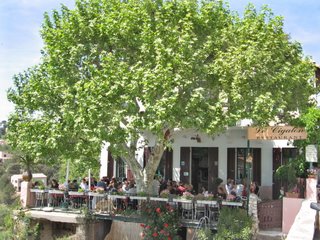 Terrace of La Cigalon restaurant. La Treille
Terrace of La Cigalon restaurant. La Treille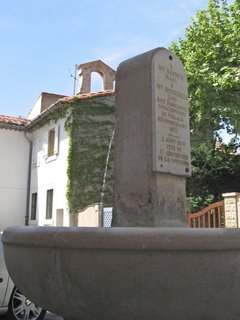 Manon's fountain. La Treille
Manon's fountain. La TreilleDetermined to find his childhood holiday home we struck off up into the hills. Today there are a number of very pleasant, rather expensive homes complete with security systems and swimming pools along the route that would not have existed in Pagnol's time. Eventually though we left them behind and climbed steadily towards the mountain of Le Taoumé. We were on the point of giving up when we came across La Bastide Neuve, and our pilgrimage was ended. It displays no obvious sign of its history and is overgrown by trees so there was little to see, but its location is just as we might have imagined. Just below is a little buvette for walkers, the last before Aix, 37 kilometres over the mountains according to a notice at the gate! We were most grateful to relax briefly in the shade with bottles of chilled spring water. The walls were hung with poor quality paintings of dead game and rifles and views of the surrounding hills. There was also a photograph of the writer.
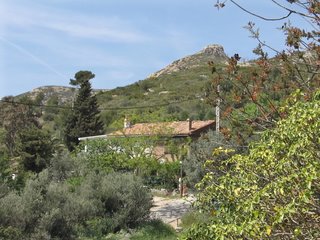 La Bastide Neuve, Pagnol's summer home in the hills above La Treille
La Bastide Neuve, Pagnol's summer home in the hills above La Treille La Grande Tête Rouge from La Bastide Neuve above La Treille
La Grande Tête Rouge from La Bastide Neuve above La TreilleOur pilgrimage complete we returned down into the village and made our way to the cemetery where the writer lies buried. He died in 1974.
 Marcel Pagnol 1895 – 1974, La Treille
Marcel Pagnol 1895 – 1974, La TreilleTime to start thinking about somewhere for the night. We decided to make for Aubagne, a place with strong links to Pagnol and apparently a couple of campsites. However, French road signing is quite hopeless and seemed to deny the very existence of Aubagne. Jill had warned Ian of the dire consequences of ending her up in the centre of Marseilles but it really was not his fault that within minutes we were heading directly down into the heart of the city along the motorway with no way off! Modestine may not be a full grown camping car but she is still more difficult to manoeuvre than a car in busy traffic and confined spaces. The next hour was a nightmare but eventually we reached Aubagne unscathed only to find it seemed as horrid as Allauch had been nice. Campsites were not signed and we didn't relish getting lost again, so we moved on to Gémenos, a pleasant, well kept little town, where we are happily settled for the night.
The problem with this area is that it is heavily populated and industrialised with many different towns all joining at the edges. The mountainous hinterland is impossible to cross so all traffic is confined to the few routes along the valleys linking the towns of the French Riviera. Having seen what we came for we are not inclined to linger to explore the major cities of Marseille and Toulon. We just cannot do everything and driving around in large congested French cities in hot sunshine is not the best way to spend our time.
In addition to being a national holiday, today is traditionally the time for giving family and friends little sprigs of lily of the valley as a token of affection and friendship. It is also an excuse to go out searching for it in family groups in woodlands. We have never seen any growing wild but there have been signs outside many farmhouses and little wayside stalls selling sprays of muguet as it is called. Very many people have been carrying sprigs of it around or wearing it in their button holes today.
Tuesday2nd May 2006, Cogolin, Côte d'Azure, Var
We are writing this blog against the really loud, rasping croak of frogs who have just started their mating call as the dusk settles and a rosy sunset glows over the nearby river.
Tonight we have settled on a campsite a few kilometres outside of St. Tropez. This will give us time to transform ourselves from scruffy campers into elegant Brits taking the Grand Tour before we make our way down into the town to mingle inconspicuously on the terraces and esplanades of this chic resort with the Saint-Tropez Smart Set!
This morning we woke to bright sunshine. We enjoyed a leisurely breakfast outside Modestine, disturbed somewhat by our neighbour, a rather strange camper with nothing but a tent, two enormous dogs and an even larger flat screen television where he sat watching French cartoons from 8am! This encouraged us to make a fairly early start and we were soon following the mountain route towards Toulon and Hyères. Not wishing to drive through Toulon we skirted the city and made for Hyères where we sought out the coast and the Presqu'île de Giens. This is certainly a very pretty place but there is only one road in and out and although it hugs the coast there are few places to park and even fewer to gain access to the tiny, rocky strips that pass for beaches. Mainly they are hidden behind houses, hotels, gardens or woodland. The best views are to be had from higher up on the hillsides. We initially had plans to visit the appetisingly named little island of Porquerolles, a twenty minute boat trip off shore. However, parking was difficult and expensive and the crossing even more expensive. So we decided we'd simply visit the little town of Giens and dine on pork rolls instead. It proved a very pleasant substitute as we picnicked overlooking the sea with views across to the three Iles d'Hyères – Porquerolles, Port-Cros and Levant.
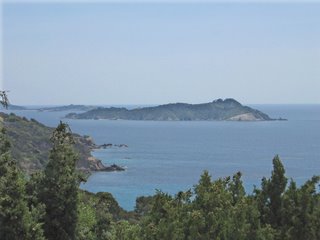 Porquerolles from Giens
Porquerolles from GiensLater we managed to find a way down to a wooden jetty that gave us delightful views along the bay of crystal clear water with the sharp outline of the mountainous coast, speckled with little orange and pink holiday villas. From the jetty healthy young wind-surfers in fetching black wetsuits were gliding effortlessly off to skim back and forth across the water. Ian's still wondering how they can race equally fast with or against the wind!
 View along the coast from Giens
View along the coast from Giens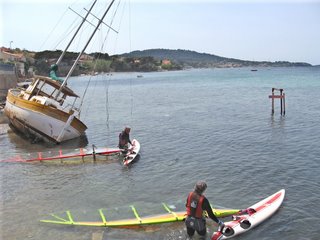 A couple of silver surfers
A couple of silver surfers Photo of us both reflected in a glass door! We really will have to work out how the camera's timer works
Photo of us both reflected in a glass door! We really will have to work out how the camera's timer worksThe scenery is quite similar to that we have seen in parts of Corsica. The tiny rocky ledges that make up beaches here are completely covered in dead vegetation washed up by the sea and include hundreds of lightweight oval disks of tightly matted fibres with nothing inside them, just as we had once found on Corsica. We have always wondered what they are and assumed they were unique to the island. After several years of wondering we have today learned that they are called Poseidonia, formed by the decaying fibres of an underwater flowering grass, rolled and tossed into fibrous balls by the action of the waves.
We continued around the tip of the peninsula which is surprisingly hilly, covered in brightly flowering shrubs, pine trees and verdant woodland. We are now back amongst the palm trees, cactuses and aloes last seen in southern Spain.
Returning to the mainland we continued via the mountainous, twisting, inland route intending to reach Saint-Tropez for the evening. Passing a Leclerc supermarket we stopped to buy cheap diesel, essentials for supper and a "baginbox" of local Provencal wine to keep them company. With a campsite on the far side of the little town we decided we'd done enough travelling for today and it was time to appreciate the sunset in what has become the Maxted's time-honoured fashion! While Jill organised supper, Ian carried out a very difficult breach delivery on the baginbox. Why are the nozzles never lined up at the right place to exit neatly from the box? The operation was eventually successfully concluded and the new arrival has brought us both much delight and pleasure!
Time now to shower and exchange our jeans and jumpers for shorts, sandals, sunhats and shades, Juan-les-Pins and Saint-Tropez await us!
Damn frogs, they are still at it!
Wednesday 3rd May 2006, St. Aygulf, Côte d'Azure, Var
There was a sign up at the camp site last night forbidding noisy disturbance after 11.30pm. The frogs stopped their rowdy behaviour exactly on time and the night became totally silent. Several minutes later a few rowdy ones who'd obviously had a great night out on the lily pads came hopping noisily home, croaking and burping!
This morning we spicked and spanned ourselves up and headed for St. Tropez. Here we discovered that it would cost us 31 euros to park Modestine in the centre for four hours because she was too tall to get under the bar into the normal car park which would have cost us 8 euros! We were obliged to return along the only route into the town for a couple of kilometres before we found anywhere at all to park. There was a benefit though; we discovered an unused little path along beside the edge of the sea that passed through the private beaches of the smart hotels with guests lounging around pools or roasting on the sand. The path afforded us beautiful views across the bright blue sea to the resort of Sainte Maxime and the whole stretch of the coastal hills beyond, towards St. Raphael. At times we needed to clamber over rocks or paddle through pools but it was far nicer than walking back alongside the busy route with traffic streaming into the town only to turn round and stream out again when they tried to park!
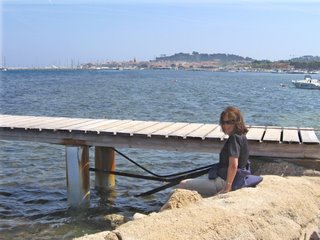 Jill enjoys the sunshine on the way to St. Tropez
Jill enjoys the sunshine on the way to St. TropezHowever, we have had a truly lovely day and found St. Tropez an enchanting place. Wealthy and beautiful people there undoubtedly were, but there were also lots of families with young children, happily building sandcastles on the narrow strip of beach and enjoying the sunshine. Down by the harbour there were huge smart yachts moored and artists selling views of the town all in the bright colours of Provence. The buildings around the edge were all in pretty oranges, pinks and yellows. They were visually delightful, exuded the charm so characteristic of the French Riviera.
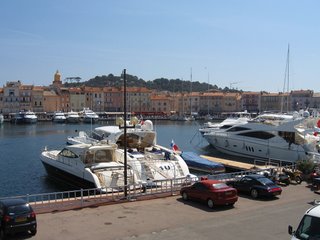 The marina at St. Tropez
The marina at St. Tropez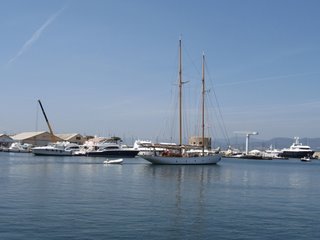 Tempting but perhaps we'll stick with Modestine! St. Tropez
Tempting but perhaps we'll stick with Modestine! St. TropezIt has been a day for relaxing, wandering the narrow streets of the old town, climbing up to the ruins of the cliff top castle and gasping with delight at the wonderful vista of sea, cliffs, trees, wild flowers, the roofs of the town and the walls of the chateau. This really is the Côte d'Azure with the sea a most iridescent blue.
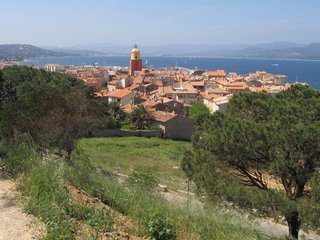 St. Tropez seen from the cliff tops
St. Tropez seen from the cliff tops One of the little coves at St. Tropez
One of the little coves at St. Tropez  The citadel, St. Tropez
The citadel, St. Tropez 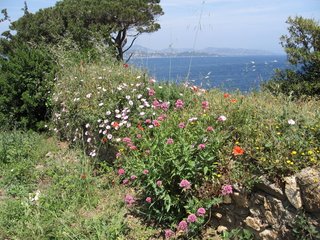 Pretty isn't it? St. Tropez
Pretty isn't it? St. Tropez 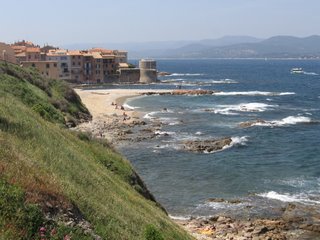 Town beach, St. Tropez
Town beach, St. Tropez We also visited the church in the town. We had wondered just who St. Tropez was and what he would have thought of the resort bearing his name. In the church we discovered he had been an important Roman official from Tuscany in the time of the emperor Nero and had been converted to Christianity. Refusing to sacrifice to Roman gods he had been beheaded, his body placed in a barge with a dog and a hen and sent out to sea. This unlikely crew eventually reached the shore here and a cult following later developed.
Menu prices were as horrific as the car parks. They started at 20 euros for a main dish and a fish meal for two was around 70 euros. So we bought sandwiches to eat with other lesser mortals on the beach before joining the mighty and the beautiful for cold drinks on the terrace of the Café des Arts from where we could also watch a boules match being played out beneath the plane trees on the Place des Lices.
It has been several days since we were last able to access the internet but decided to wait a little longer when we were quoted 7 euros an hour for access! That's the most expensive we've encountered anywhere! So we returned to Modestine by the same seaside route only to join a slow crawl of traffic back to the main road and all the way around the bay to Sainte Maxime. Here we stopped to look around and wait for the traffic to disappear.
It is said that Sainte Maxime is full of people wishing they could afford to stay in St. Tropez. This may be so, but certainly we found it to be a very pleasant place indeed and a more realistic centre for a family holiday. It is right on the bay with views across to St. Tropez. Usually there are ferries between the two resorts but despite the hot sunshine today, the sea was considered too rough and windy for them to run. Both resorts are spotlessly clean and in excellent repair.
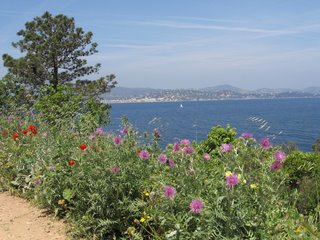 Ste. Maxime seen from across the water at St. Tropez
Ste. Maxime seen from across the water at St. Tropez 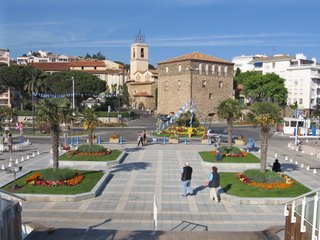 Seafront at St. Maxime
Seafront at St. Maxime Marina with slightly smaller yachts at St. Maxime
Marina with slightly smaller yachts at St. MaximeWe strolled along the front, explored a flea-market on the esplanade, pottered around the harbour, larger than St. Tropez but with smaller and less ostentatious yachts moored there. Back in the older part of the town we found a maze of little streets lined with inviting bars, restaurants and shops. It was a pity it was so late in the day as we could have spent far longer in the town.
The traffic had eased by the time we returned to Modestine and we continued along the spectacular coast road bordered by shady umbrella pines, right beside the sea, until we turned off at this campsite, found by chance from a road sign. It has proved to be a good choice with excellent facilities. It goes into our top ten sites somewhere near the top! We have used the washing machine and have a long line of duvet covers, towels and jumpers blowing in the sea breeze outside. The site has direct access to the beach. Over the winter months virtually every site we used in Spain and Portugal had access to the beach but it was generally too unpleasant, wet and cold to care. Here we will be able to take a stroll on the sand before breakfast!
Our Berlitz guidebook informs us that the Cannes film festival takes place in early May when the place is bursting at the seams with the classy and the brassy! A chance to rub shoulders with the greats of the French cinema! We are heading that way so who knows, Modestine may be spotted and offered a starring role in the next French film along with Gerard Depardieu! The imagination boggles! He's a big chap! Would he fit in Modestine?
Thursday 4th May 2006, Cannes, Côte d'Azur
Before we left last night's wonderful campsite we went for a stroll on our own sandy beach. Already it was getting too hot for comfort but the sea was far too rough for swimming.
 The beach at the campsite at St. Aygulf
The beach at the campsite at St. AygulfThe Cote d'Azur really is spectacularly beautiful. Modern developments have been tastefully done and there are some amazing properties with stunning views. The coastal road stretches all the way from St. Tropez to the Italian border. On the way it passes through many fashionable resorts. Our route today took us through St. Raphael and along the Corniche de l'Esterel to Cannes. The twisting road climbs its way up and through the Corniche, a majestic landscape of bare red rocks, known as les Calanques, gnarled and twisted into rugged sculptures, their red outline stark against the bright blue of the sea. This coastal landscape reminded us very much of Corsica, particularly the west coast and the area around the Calanche. The word calanques in French means coves or inlets. Possibly calanche, is a Corsican dialect word for the same thing. Up here we were able to stop to admire the scenery. In the towns it is quite impossible. There is a definite policy to keep camping cars away from the area. There is plenty of parking provision for cars but none for vehicles over 1.9 metres. So although Modestine is small, we still cannot park her.
 Cap Roux, Corniche de l'Esterel
Cap Roux, Corniche de l'Esterel We took one for them so they took one for us! Cap Roux, Corniche de l'Esterel
We took one for them so they took one for us! Cap Roux, Corniche de l'EsterelModestine won't be starring in the next block-buster after all. Not only was Gerard Depardieu nowhere to be seen in Cannes, the festival doesn't actually start until 17th May so all we saw was the exterior of the Palais des Festivals et des Congrès and lots of security staff making sure nobody got inside disguised as one of the many workmen busy erecting tents, banners and other assorted fripperies in preparation for the event. We decided, in the light of experience, not to try to park in Cannes but to leave Modestine in the shade of the cliffs at the beautiful little seaside resort of Théoule and ride into Cannes on the bus. This proved to be one of our better ideas. When we found the seafront bus-stop a lively but elderly man in shorts with a walking stick informed us the bus was due in a few minutes. It arrived, a haven of air conditioned comfort on such a hot sticky day. Our travelling companion requested the cheerful lady driver to make a slight detour from her route as a favour as he was 94 years old and had already walked right along the seafront and was feeling tired! The driver made some comment about thinking he was only in his 20s but made no bones about diverting. It only made us fifteen minutes late reaching our destination!
We only had a few hours to explore the town but it was sufficient to get a flavour of the place. It is full of very nice pedestianised areas with countless bars and cafés. Down on the sea front there are shady palm trees along to the harbour with enormous yachts anchored in the marina. Right on the sea's edge, surrounded by the boats, stands the Palais des Festivals where the award ceremonies will take place in a couple of weeks. Next to it stands one of the town's three casinos. This was a place we felt we could ignore. Soon we will have bigger fish to fry when we attempt to break the bank at Monte Carlo!
 Palais des Festivals et des Congrès, Cannes
Palais des Festivals et des Congrès, Cannes Harbour with view towards the citadel, Cannes
Harbour with view towards the citadel, Cannes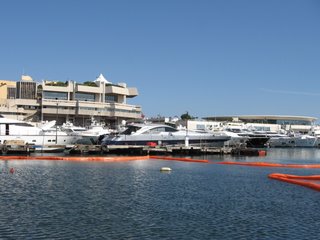 Palais des Festivals and the transport of the super-rich, Cannes
Palais des Festivals and the transport of the super-rich, Cannes Plage du Midi, Cannes
Plage du Midi, CannesWhen Ian sees a hill he is automatically programmed to climb it regardless of the temperature or what other exciting things there may be to do instead. So we abandoned the centre of the town and climbed up to the old castle above. (Unfortunately for Jill almost every town in France seems to have an old ruined castle high on a hill nearby!) To be fair, the views over the town and back along the rugged hills bordering the coast were splendid and the slight breeze up there was refreshing.
 View of the town from the citadel, Cannes
View of the town from the citadel, CannesSoon we had to make our way back to the bus station to find our same bus driver for the enjoyable ride back along the sea front to rejoin Modestine. On the way we stopped to buy Chinese food for supper which we later ate in the evening sunshine on this very pleasant campsite a few kilometres outside of Cannes.
